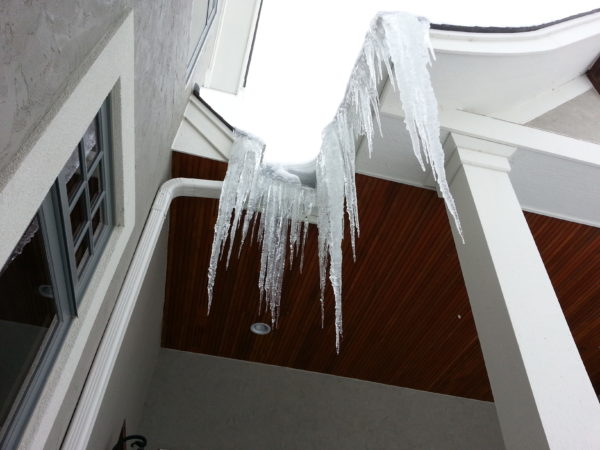Preventing Ice Dams
What can be done to prevent ice dams?
Preventing Ice Dams falls under two categories:
- Treating the causes
- Treating the symptoms
Sometimes the solution requires a combination of both. Understanding why the ice dam is forming is critical to preventing it. Ice dams form because snow on the roof melts even though the outside temperatures are below 32 degrees.
The melted snow flows down the roof to points where it is slowed and collected (such as valleys, crickets, saddles), or where it is exposed directly to the air (such as the roof edge or gutter). Repeated cycles of this melting and freezing continues until a ridge of ice or a “dam” is formed.
This dam traps water behind it and forces water into areas where it normally wouldn’t flow if the ridge of ice weren’t present. Another problem with ice dams are the icicles that form and pose safety problems to whatever is below.
Ice Dam Causes
Conditioned (heated) air from the living space escaping into the attic space is a major contributor to ice dam formation. This can be through any penetration in the ceiling – can lights, attic access doors, un-ducted exhaust fans, openings around chimneys, etc. Poor levels of insulation allow heat to be conducted into the attic resulting in additional warming. Solar gain (the roof surface being warmed by the sun) and temperatures fluctuating above and below freezing melt snow which provides water for building ice dams. Improper ventilation of the attic also plays a role.
Ice Dam Prevention
INSIDE:
If the ice dams are caused from what is happening inside the home treat those causes first. The absolute first step is to seal all (or as many as possible) of the air bypasses that are allowing conditioned air to enter the attic space. Some of these can be done as a DIY project. More complicated air sealing requirements should be done by a qualified contractor. Without doing this first, adding insulation or improving ventilation will have little effect. This is the most common mistake many make when trying to solve ice dam problems.
After sealing the air bypasses, then make sure insulation and ventilation is to current building codes. Another common mistake some make is adding power ventilation on difficult to ventilate homes without first air sealing. This increases the likelihood of drawing conditioned air from the living space, driving up energy costs and having little effect on ice dam prevention.
OUTSIDE:
If the ice dams are caused by what is happening outside what has been done on the inside will have little effect. Even new homes built to current codes can suffer. With the complex architecture so common, homes can have higher roof sections exposed to the sun with lower sections shaded.
Melt water is often funneled to small gutter lines where refreezing and ice dams occur. Good roofing practices can go a long way in preventing the leaking. The use of ice and water shield (waterproofing underlayment) can stop melt water from entering the structure. These products are not fool proof, though. And they do nothing to stop ice dams and icicles from forming.

Roof Heat Cables
Heat cables are often used to prevent ice dams when other remedies have failed. This is commonly referred to as treating the symptom. Heat cables are effective in combating ice dams which are caused by external forces. They can keep ice from forming in the first place.
Good design is essential. The most common application is zig zag heat tape which is strung along the eave. While appropriate for moderate snow falls, when snowfall increases the zig zag application can struggle to keep up. There are also radiant panels (such as Edge Melt Systems™) made of aluminum with commercial grade heat cables embedded in them. These are placed in valleys and at the eaves along with heat cables in the gutter bottom and downspouts. They are more effective at preventing the buildup of ice and have a longer lifespan. They are also more effective when snowfall is heavier.
Ice dam prevention can be accomplished. The key is understanding the cause of your problem. Houses differ, so the cure that works on one home may not work for another. If you are unsure, consult an expert that specialize in determining the cause and recommending the solution.










